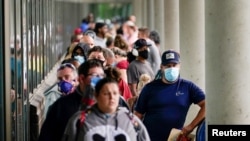Some 787,000 U.S. workers filed for unemployment compensation last week, a historically high level but 73,000 fewer than the previous week, the U.S. Labor Department reported Thursday, as the coronavirus pandemic continues to weaken the American labor market seven months after it began.
More than 8.4 million workers remain unemployed in the United States, with the jobless rate at 7.9% for the week ending October 10, and economists saying the figure could remain elevated for months. Only slightly more than half of the 22 million U.S. jobs lost in the coronavirus pandemic have been recovered.
The recent weekly claims figures are well below the 6.9 million record number of claims filed in late March as the coronavirus swept into the United States but remain above the highest pre-pandemic level in records going back to the 1960s.
U.S. employers have called back millions of workers who were laid off during business shutdowns earlier this year, yet some hard-hit businesses have been slow to ramp up their operations again or have closed permanently, leaving workers idled or searching for new employment as coronavirus cases are surging again.
In addition, such major corporations as AT&T, Warner Media, Walt Disney, and Allstate, along with several airlines, have announced major layoffs in recent weeks as the U.S. economy, the world’s largest, struggles to regain its footing.
President Donald Trump and Democratic lawmakers have been unable to reach an agreement during weeks of negotiations over a new coronavirus relief package, although talks are continuing.
Extra $600-a-week national government payments to unemployed workers on top of less generous state jobless benefits expired at the end of July. Academic studies show that as a result, millions of people have fallen back into poverty, although the exact number is uncertain.
With less than two weeks until the official Election Day, and millions of people already casting early ballots, the prospect for a new aid deal before Nov. 3, including unemployment assistance, appears limited.
Treasury Secretary Steven Mnuchin and House Speaker Nancy Pelosi, who is leading the negotiations for Democrats, have held talks this week and are scheduled to speak again on Thursday. White House Chief of Staff Mark Meadows suggested Wednesday that President Trump is becoming less willing to yield to demands from Democrats.
“Most of the progress we’ve made have been concessions that the president has made to date,” Meadows said. “The next two or three days will make the biggest difference.”
House Speaker Nancy Pelosi said the two sides remain divided on several issues, including a strategic coronavirus testing plan. Pelosi said Wednesday on MSNBC, “Let's keep working so that we can do it after the election.”
“It’s a question of, is it in time to pay the November rent, which is my goal, or is it going to be shortly thereafter and retroactive,” Pelosi added.
The White House last weekend offered a $1.88 trillion relief package, bringing it closer to the $2.2 trillion deal Pelosi wants. But the details of a deal remain elusive.
A compromise plan, even at the lower end of the spending range, would still face an uncertain fate in the majority-Republican Senate, with several Republican lawmakers expressing opposition to a package of that size or any new assistance at all.
Trump has contended that the U.S. economy is in the midst of a V-shaped recovery, but the country is still down about 10 million jobs from February, a bigger loss than the 8.7 million seen during the 2008-2009 recession.
There has also been a surge in new U.S. coronavirus cases to more than 58,000 a day, seemingly headed to another national peak in infections. The U.S. has recorded more than 220,000 deaths and 8.3 million cases since the pandemic started in March, with both figures more than in any other country, according to Johns Hopkins University.







